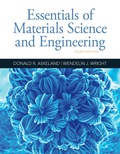
(a)
Interpretation:
The total
Concept Introduction:
The compound formula of Lead-Tin alloy is designated by 'Pb-Sn'.
- It appears in solid form.
- It appears in various shapes like wire, ingot, foil, bar, ribbon etc.
- It appears in silver color.
- Its melting point is 182-215 degree Celsius.
Lead-Tin are widely used as soldering alloys. They are compatible for all types of uses.
Answer to Problem 11.26P
The Total %
Explanation of Solution
Given:
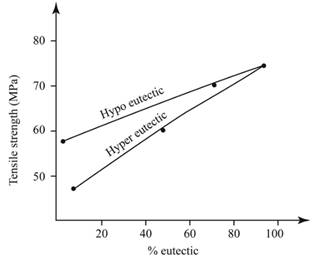
Calculations:
From the graph,
For %
% Eutectic = 0.
Thus, the evaluated value of %
(b)
Interpretation:
The total
Concept Introduction:
The compound formula of Lead-Tin alloy is designated by 'Pb-Sn'.
- It appears in solid form.
- It appears in various shapes like wire, foil, bar, ribbon etc.
- It appears in silver color.
- Its melting point is 182-215 degree Celsius.
Lead-Tin are widely used as soldering alloys. They are compatible for all types of uses.
Answer to Problem 11.26P
The Total %
Explanation of Solution
Given:
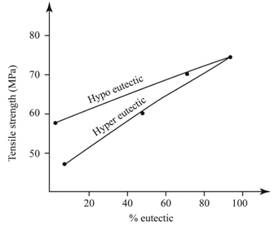
Calculations:
From the graph,
For %
% Eutectic =
The evaluated value of %
(c)
Interpretation:
The total
Concept Introduction:
The compound formula of Lead-Tin alloy is designated by 'Pb-Sn'.
- It appears in solid form.
- It appears in various shapes like wire, foil, bar, ribbon etc.
- It appears in silver color.
- Its melting point is 182-215 degree Celsius.
Lead-Tin are widely used as soldering alloys. They are compatible for all types of uses.
Answer to Problem 11.26P
The Total %
Explanation of Solution
Given:
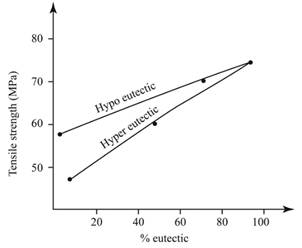
Calculations:
From the diagram,
For %
% Eutectic =
The evaluated value of %
(d)
Interpretation:
The total
Concept Introduction:
The compound formula of Lead-Tin alloy is designated by 'Pb-Sn'.
- It appears in solid form.
- It appears in various shapes like wire,foil, bar, ribbon etc.
- It appears in silver color.
- Its melting point is 182-215 degree Celsius.
Lead-Tin are widely used as soldering alloys. They are compatible for all types of uses.
Answer to Problem 11.26P
The Total %
Explanation of Solution
Given:
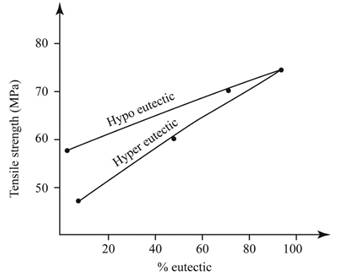
Calculations:
From the graph,
For %
% Eutectic =
The evaluated value of %
(e)
Interpretation:
The total
Concept Introduction:
The compound formula of Lead-Tin alloy is designated by 'Pb-Sn'.
- It appears in solid form.
- It appears in various shapes like wire, foil, bar, ribbon etc.
- It appears in silver color.
- Its melting point is 182-215 degree Celsius.
Lead-Tin are widely used as soldering alloys. They are compatible for all types of uses.
Answer to Problem 11.26P
The Total %
Explanation of Solution
Use spreadsheet to tabulate the % total
| Composition of % in entire phase diagram | Tensile Strength ( | Total % phase | % Eutectic |
| 10 | 30 | 8.2 | 0 |
| 20 | 40 | 18.6 | 2.3 |
| 50 | 50 | 49.5 | 72.3 |
| 60 | 60 | 59.8 | 95.6 |
| 80 | 70 | 80.4 | 49.6 |
| 95 | 80 | 95.9 | 7 |
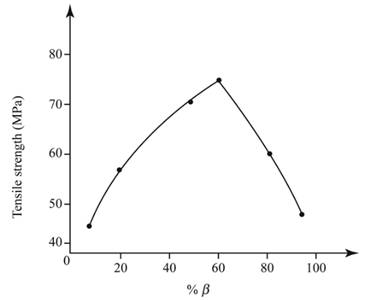
Given:
Calculations:
From the graph:
For %
% Eutectic =
Thus, by using the expression of eutectic, the required value obtained is 49.2%.
(f)
Interpretation:
The total
Concept Introduction:
The compound formula of Lead-Tin alloy is designated by 'Pb-Sn'.
- It appears in solid form.
- It appears in various shapes like wire, foil, bar, ribbon etc.
- It appears in silver color.
- Its melting point is 182-215 degree Celsius.
Lead-Tin are widely used as soldering alloys. They are compatible for all types of uses.
Answer to Problem 11.26P
The Total %
Explanation of Solution
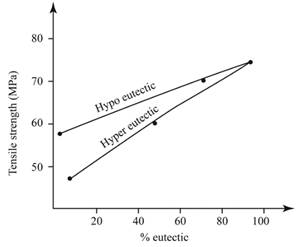
Given:
Calculations:
For %
% Eutectic =
(Mention Graph)
After Studying the graph of tensile strength vs %
The evaluated value of %
Want to see more full solutions like this?
Chapter 11 Solutions
Essentials Of Materials Science And Engineering
- PROBLEM 2.50 1.8 m The concrete post (E-25 GPa and a = 9.9 x 10°/°C) is reinforced with six steel bars, each of 22-mm diameter (E, = 200 GPa and a, = 11.7 x 10°/°C). Determine the normal stresses induced in the steel and in the concrete by a temperature rise of 35°C. 6c " 0.391 MPa 240 mm 240 mm 6₁ = -9.47 MPaarrow_forwardI need help on this question. step by step calculations and answers.arrow_forwardDon't use ai to answer I will report you answerarrow_forward
- jan G(f) f Sketch the spectrum of g(t), which has a maximum frequency of 5 kHz, if it is sampled at the following sampling frequencies: 7 kHz, 10 kHz and 15 kHz. Indicate if and how the signal can be recovered at each sampling frequency.arrow_forwardDon't use ai to answer i will report your answerarrow_forwardA single tone is modulated using FM transmitter. The SNR, at the input of the demodulator 20 dB. If the maximum frequency of the modulating signal is 4 kHz, and the maximum equency deviation is 12 kHz, find the SNR, and the bandwidth (using Carson rule) at the ollowing conditions: . For the given values of fm and Af. !. If the amplitude of the modulating signal is increased by 80%. 3. If the amplitude of the modulating signal is decreased by 50%, and frequency of modulating signal is increased by 50%.arrow_forward
- The circuit shown below on the left has the following parameters: V₁ = 5 V. R₁ = 40, R₂ = 40, α = 0.1. This circuit can be replaced by an equivalent circuit shown below on the right such that the voltage and current received by an arbitrary load resistor RL, are identical when connected to either circuits. Determine the value of the resistor R (in ) in the equivalent circuit. R₁ Rx R2 R₁ Vx R₁ Vi απ. barrow_forwardLab 07: Java Graphics (Bonus lab) In this lab, we'll be practicing what we learned about GUIs, and Mouse events. You will need to implement the following: ➤ A GUI with a drawing panel. We can click in this panel, and you will capture those clicks as a Point (see java.awt.Point) in a PointCollection class (you need to build this). о The points need to be represented by circles. Below the drawing panel, you will need 5 buttons: о An input button to register your mouse to the drawing panel. ○ о о A show button to paint the points in your collection on the drawing panel. A button to shift all the points to the left by 50 pixels. The x position of the points is not allowed to go below zero. Another button to shift all the points to the right 50 pixels. The x position of the points cannot go further than the You can implement this GUI in any way you choose. I suggest using the BorderLayout for a panel containing the buttons, and a GridLayout to hold the drawing panel and button panels.…arrow_forwardK/S 46. (O المهمات الجديدة 0 المنتهية 12 المغـ ۱۱:۰۹ search ليس لديك اي مهمات ☐ ○ ☑arrow_forward
- the answer should be: V2= -(P0-PL/2μL)(dx-x^)+Ux/darrow_forwardFor some viscoelastic polymers that are subjected to stress relaxation tests, the stress decays with time according to a(t) = a(0) exp(-4) (15.10) where σ(t) and o(0) represent the time-dependent and initial (i.e., time = 0) stresses, respectively, and t and T denote elapsed time and the relaxation time, respectively; T is a time-independent constant characteristic of the material. A specimen of a viscoelastic polymer whose stress relaxation obeys Equation 15.10 was suddenly pulled in tension to a measured strain of 0.5; the stress necessary to maintain this constant strain was measured as a function of time. Determine E (10) for this material if the initial stress level was 3.5 MPa (500 psi), which dropped to 0.5 MPa (70 psi) after 30 s.arrow_forward1. Consider the following a unity feedback control system. R(s) + E(s) 500(s+2)(s+5)(s+6) s(s+8)(s+10)(s+12) -Y(s) Find the followings: a) Type of the system b) Static position error constant Kp, Static velocity error constant Ry and Static acceleration error constant Ka c) Find the steady-state error of the system for (i) step input 1(t), (ii) ramp input t 1(t), (iii) parabolic input t² 1(t). 2. Repeat the above problem for the following system. R(s) + E(s) 500(s + 2)(s + 5) (s+8)(s+ 10)(s+12) Y(s) 3. Repeat the above problem for the following system. R(s) + E(s) 500(s+2)(s+4)(s+5)(s+6)(s+7) s²(s+8)(s+10)(s+12) Y(s)arrow_forward
 MATLAB: An Introduction with ApplicationsEngineeringISBN:9781119256830Author:Amos GilatPublisher:John Wiley & Sons Inc
MATLAB: An Introduction with ApplicationsEngineeringISBN:9781119256830Author:Amos GilatPublisher:John Wiley & Sons Inc Essentials Of Materials Science And EngineeringEngineeringISBN:9781337385497Author:WRIGHT, Wendelin J.Publisher:Cengage,
Essentials Of Materials Science And EngineeringEngineeringISBN:9781337385497Author:WRIGHT, Wendelin J.Publisher:Cengage, Industrial Motor ControlEngineeringISBN:9781133691808Author:Stephen HermanPublisher:Cengage Learning
Industrial Motor ControlEngineeringISBN:9781133691808Author:Stephen HermanPublisher:Cengage Learning Basics Of Engineering EconomyEngineeringISBN:9780073376356Author:Leland Blank, Anthony TarquinPublisher:MCGRAW-HILL HIGHER EDUCATION
Basics Of Engineering EconomyEngineeringISBN:9780073376356Author:Leland Blank, Anthony TarquinPublisher:MCGRAW-HILL HIGHER EDUCATION Structural Steel Design (6th Edition)EngineeringISBN:9780134589657Author:Jack C. McCormac, Stephen F. CsernakPublisher:PEARSON
Structural Steel Design (6th Edition)EngineeringISBN:9780134589657Author:Jack C. McCormac, Stephen F. CsernakPublisher:PEARSON Fundamentals of Materials Science and Engineering...EngineeringISBN:9781119175483Author:William D. Callister Jr., David G. RethwischPublisher:WILEY
Fundamentals of Materials Science and Engineering...EngineeringISBN:9781119175483Author:William D. Callister Jr., David G. RethwischPublisher:WILEY





